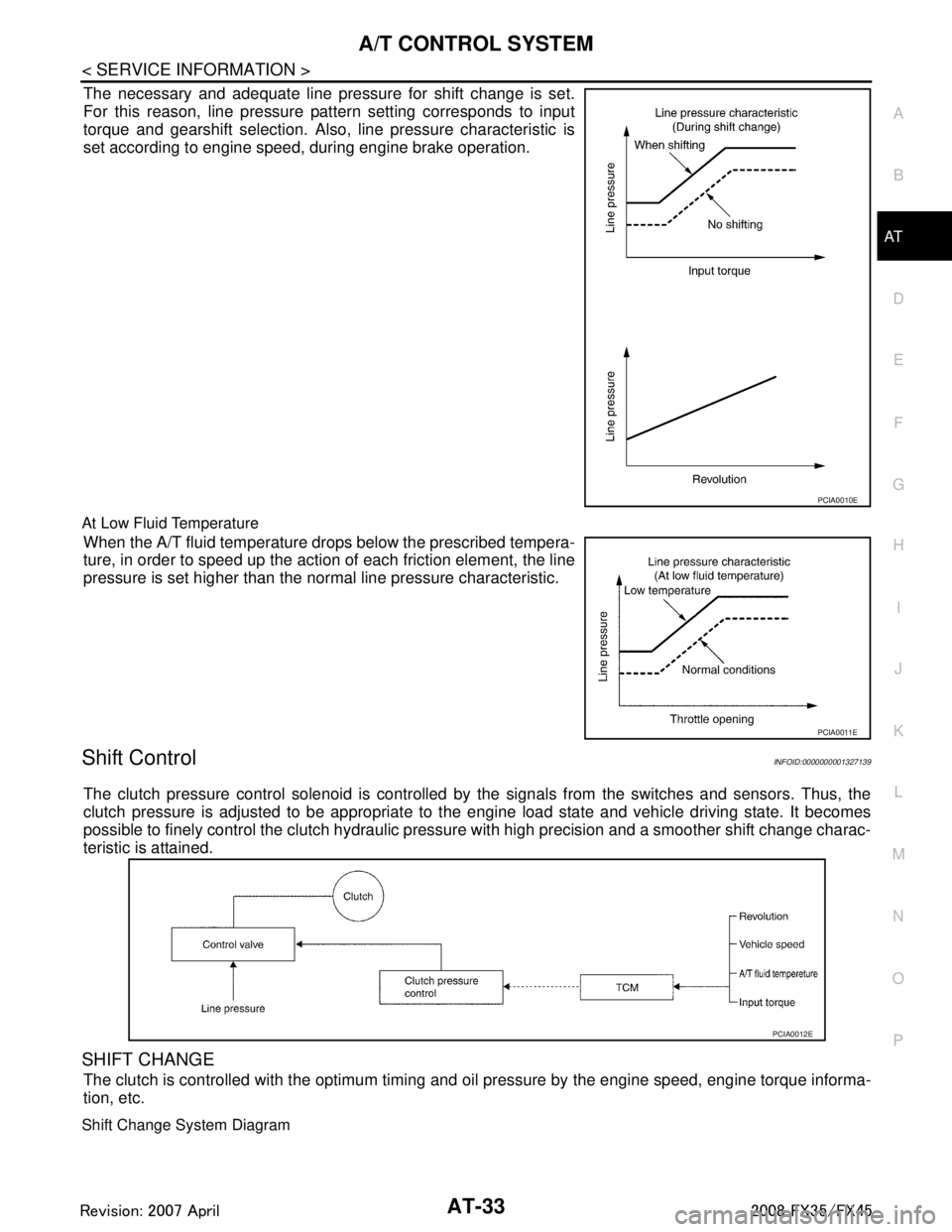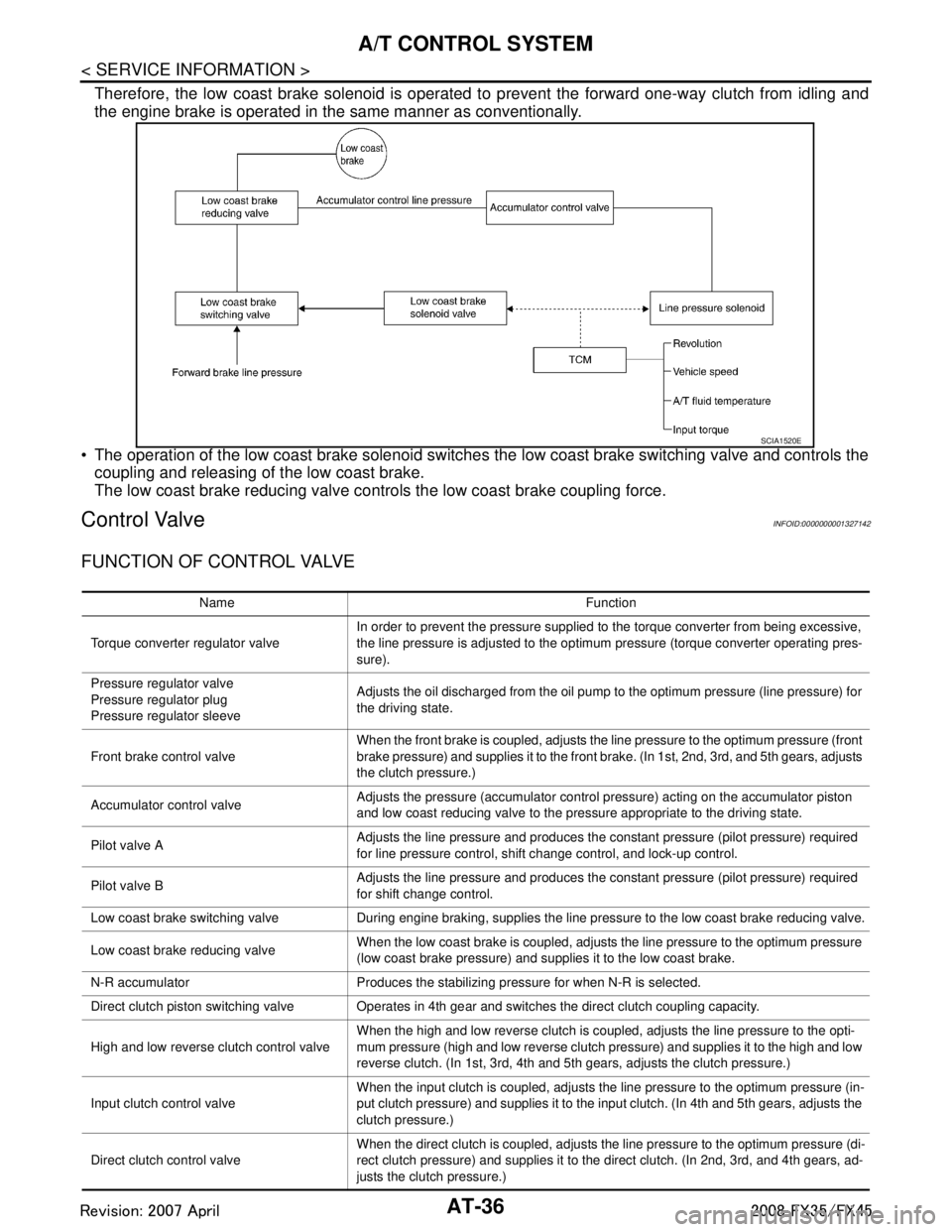2008 INFINITI FX35 low oil pressure
[x] Cancel search: low oil pressurePage 21 of 3924
![INFINITI FX35 2008 Service Manual
ACS-14
< SERVICE INFORMATION >[ICC]
LASER BEAM AIMING ADJUSTMENT
LASER BEAM AIMING ADJUSTMENT
OutlineINFOID:0000000001328812
Adjust the laser beam aiming every time the ICC sensor is removed or insta INFINITI FX35 2008 Service Manual
ACS-14
< SERVICE INFORMATION >[ICC]
LASER BEAM AIMING ADJUSTMENT
LASER BEAM AIMING ADJUSTMENT
OutlineINFOID:0000000001328812
Adjust the laser beam aiming every time the ICC sensor is removed or insta](/manual-img/42/57017/w960_57017-20.png)
ACS-14
< SERVICE INFORMATION >[ICC]
LASER BEAM AIMING ADJUSTMENT
LASER BEAM AIMING ADJUSTMENT
OutlineINFOID:0000000001328812
Adjust the laser beam aiming every time the ICC sensor is removed or installed.
CAUTION:
Adjust laser beam aiming at a horizontal place as
far as 12 m (39 ft) forward the vehicle can be seen.
Adjust laser beam aiming 5 seconds after starting engine.
Never view ICC sensor integrated un it body window directly during laser beam aiming adjustment.
Follow the CONSULT-III when adju sting the laser beam aiming (laser beam aiming adjustment can-
not be operated without CONSULT-III).
Never ride on vehicle during l aser beam aiming adjustment.
Idle and turn headlamps OFF duri ng laser beam aiming adjustment.
PreparationINFOID:0000000001328813
Adjust the tire pressure to the specified value.
See that there is no load in the vehicle.
Coolant, engine oil filled up to correct level and full fuel tank.
Shift the gear into “P” position and release the parking brake.
Clean the ICC sensor with a soft cloth.
Outline of Adjustment ProcedureINFOID:0000000001328814
1. Set up the ICC target board [KV99110100 (J-45718)].
2. Adjust the sensor following the procedure on CONSUL T-III. (Turn manually the screw for up-down position
adjustment. ICC sensor automatically adjust the right-left position.)
Setting the ICC Target BoardINFOID:0000000001328815
Accurate ICC target board setting is required for the laser beam aiming adjustment.
CAUTION:
ICC system does not function normally if laser beam aiming is not accurate.
ADJUSTING HEIGHT OF THE TARGET
1. Attach a triangle scale at the center.
SKIA6179E
SKIA5974E
3AA93ABC3ACD3AC03ACA3AC03AC63AC53A913A773A893A873A873A8E3A773A983AC73AC93AC03AC3
3A893A873A873A8F3A773A9D3AAF3A8A3A8C3A863A9D3AAF3A8B3A8C
Page 77 of 3924

AT-4
BRAKE SIGNAL CIRCUIT ..............................165
CONSULT-III Reference Value in Data Monitor
Mode .................................................................... ..
165
Diagnosis Procedure .............................................165
A/T INDICATOR CIRCUIT ...............................166
Description ........................................................... ..166
CONSULT-III Reference Value in Data Monitor
Mode .................................................................... ..
166
Diagnosis Procedure .............................................166
TROUBLE DIAGNOSIS FOR SYMPTOMS .....167
Wiring Diagram - AT - NONDTC .......................... ..167
A/T Check Indicator Lamp Does Not Come On .....170
Engine Cannot Be Started in "P" or "N" Position ...170
In "P" Position, Vehicle Moves When Pushed .......171
In "N" Position, Vehicle Moves ..............................172
Large Shock ("N" to "D" Position) ..........................173
Vehicle Does Not Creep Backward in "R" Position ..175
Vehicle Does Not Creep Forward in "D" Position ..178
Vehicle Cannot Be Started from D1 .......................180
A/T Does Not Shift: D1→ D2 ................................ ..182
A/T Does Not Shift: D2→ D3 ................................ ..184
A/T Does Not Shift: D3→ D4 ................................ ..186
A/T Does Not Shift: D4→ D5 ................................ ..188
A/T Does Not Lock-up ......................................... ..190
A/T Does Not Hold Lock-up Condition ...................192
Lock-up Is Not Released .......................................194
Engine Speed Does Not Return to Idle .................194
Cannot Be Changed to Manual Mode ...................195
A/T Does Not Shift: 5th Gear → 4th Gear ........... ..196
A/T Does Not Shift: 4th Gear → 3rd Gear ........... ..197
A/T Does Not Shift: 3rd Gear → 2nd Gear .......... ..199
A/T Does Not Shift: 2nd Gear → 1st Gear ........... ..201
Vehicle Does Not Decelerate by Engine Brake ... ..202
SHIFT CONTROL SYSTEM ............................205
Control Device Removal and Installation ............. ..205
Control Rod Removal and Installation ...................206
Adjustment of A/T Position ....................................207
Checking of A/T Position .......................................207
A/T SHIFT LOCK SYSTEM .............................208
Description ........................................................... ..208
Shift Lock System Electrical Parts Location ..........208
Wiring Diagram - AT - SHIFT .................................209
Diagnosis Procedure .............................................209
KEY INTERLOCK CABLE ...............................212
Component .......................................................... ..212
Removal and Installation .......................................212
ON-VEHICLE SERVICE ...................................215
Control Valve with TCM and A/T Fluid Tempera-
ture Sensor 2 ....................................................... .
215
Parking Component (2WD Models Only) ..............226
Rear Oil Seal .........................................................233
Revolution Sensor Component (2WD Models
Only) .....................................................................
233
AIR BREATHER HOSE ....................................239
Removal and Installation ...................................... .239
TRANSMISSION ASSEMBLY ..........................241
Removal and Installation (2WD Models) .............. .241
Removal and Installation (AWD Models) ..............243
OVERHAUL ......................................................249
Component .......................................................... .249
Oil Channel ...........................................................261
Location of Adjusting Shims, Needle Bearings,
Thrust Washers and Snap Rings ......................... .
264
DISASSEMBLY .............................................. ..267
Disassembly ......................................................... .267
REPAIR FOR COMPONENT PARTS ..............285
Oil Pump .............................................................. .285
Front Sun Gear, 3rd One-Way Clutch ...................287
Front Carrier, Input Clutch, Rear Internal Gear .....289
Mid Sun Gear, Rear Sun Gear, High and Low Re-
verse Clutch Hub ..................................................
295
High and Low Reverse Clutch ..............................301
Direct Clutch .........................................................303
ASSEMBLY .................................................... ..306
Assembly (1) ........................................................ .306
Adjustment ............................................................320
Assembly (2) .........................................................323
SERVICE DATA AND SPECIFICATIONS
(SDS) ................................................................
330
General Specification ........................................... .330
Vehicle Speed at Which Gear Shifting Occurs .....330
Vehicle Speed at Which Lock-up Occurs/Releas-
es ..........................................................................
331
Stall Speed ............................................................331
Line Pressure ........................................................331
A/T Fluid Temperature Sensor ..............................332
Turbine Revolution Sensor ...................................332
Vehicle Speed Sensor A/T (Revolution Sensor) ...332
Reverse Brake ......................................................332
Total End Play .......................................................332
3AA93ABC3ACD3AC03ACA3AC03AC63AC53A913A773A893A873A873A8E3A773A983AC73AC93AC03AC3
3A893A873A873A8F3A773A9D3AAF3A8A3A8C3A863A9D3AAF3A8B3A8C
Page 106 of 3924

A/T CONTROL SYSTEMAT-33
< SERVICE INFORMATION >
DE
F
G H
I
J
K L
M A
B
AT
N
O P
The necessary and adequate line pressure for shift change is set.
For this reason, line pressure pattern setting corresponds to input
torque and gearshift selection. Also, line pressure characteristic is
set according to engine speed, during engine brake operation.
At Low Fluid Temperature
When the A/T fluid temperature drops below the prescribed tempera-
ture, in order to speed up the action of each friction element, the line
pressure is set higher than the normal line pressure characteristic.
Shift ControlINFOID:0000000001327139
The clutch pressure control solenoid is controlled by the signals from the switches and sensors. Thus, the
clutch pressure is adjusted to be appropriate to t he engine load state and vehicle driving state. It becomes
possible to finely control the clutch hydraulic pressu re with high precision and a smoother shift change charac-
teristic is attained.
SHIFT CHANGE
The clutch is controlled with the optimum timing and oil pressure by the engine speed, engine torque informa-
tion, etc.
Shift Change System Diagram
PCIA0010E
PCIA0011E
PCIA0012E
3AA93ABC3ACD3AC03ACA3AC03AC63AC53A913A773A893A873A873A8E3A773A983AC73AC93AC03AC3
3A893A873A873A8F3A773A9D3AAF3A8A3A8C3A863A9D3AAF3A8B3A8C
Page 109 of 3924

AT-36
< SERVICE INFORMATION >
A/T CONTROL SYSTEM
Therefore, the low coast brake solenoid is operated to prevent the forward one-way clutch from idling and
the engine brake is operated in the same manner as conventionally.
The operation of the low coast brake solenoid switches the low coast brake switching valve and controls the
coupling and releasing of the low coast brake.
The low coast brake reducing valve contro ls the low coast brake coupling force.
Control ValveINFOID:0000000001327142
FUNCTION OF CONTROL VALVE
SCIA1520E
Name Function
Torque converter regulator valve In order to prevent the pressure supplied to the torque converter from being excessive,
the line pressure is adjusted to the optimum pressure (torque converter operating pres-
sure).
Pressure regu lator valve
Pressure regulator plug
Pressure regu lator sleeve Adjusts the oil discharged from the oil pump to the optimum pressure (line pressure) for
the driving state.
Front brake control valve When the front brake is coupled, adjusts the line pressure to the optimum pressure (front
brake pressure) and supplies it to the front brake. (In 1st, 2nd, 3rd, and 5th gears, adjusts
the clutch pressure.)
Accumulator control valve Adjusts the pressure (accumulator control pressure) acting on the accumulator piston
and low coast reducing valve to the pressure appropriate to the driving state.
Pilot valve A Adjusts the line pressure and produces the constant pressure (pilot pressure) required
for line pressure control, shift change control, and lock-up control.
Pilot valve B Adjusts the line pressure and produces the constant pressure (pilot pressure) required
for shift change control.
Low coast brake switching valve During engine braking, supplies the line pressure to the low coast brake reducing valve.
Low coast brake reducing valve When the low coast brake is coupled, adjusts the line pressure to the optimum pressure
(low coast brake pressure) and supplies it to the low coast brake.
N-R accumulator Produces the stabilizing pressure for when N-R is selected.
Direct clutch piston switching valve Operates in 4th ge ar and switches the direct clutch coupling capacity.
High and low reverse clutch control valve When the high and low reverse clutch is coupled, adjusts the line pressure to the opti-
mum pressure (high and low reverse clutch pressure) and supplies it to the high and low
reverse clutch. (In 1st, 3rd, 4th and 5th gears, adjusts the clutch pressure.)
Input clutch control valve When the input clutch is coupled, adjusts the line pressure to the optimum pressure (in-
put clutch pressure) and supplies it to the input clutch. (In 4th and 5th gears, adjusts the
clutch pressure.)
Direct clutch control valve When the direct clutch is coupled, adjusts the line pressure to the optimum pressure (di-
rect clutch pressure) and supplies it to the direct clutch. (In 2nd, 3rd, and 4th gears, ad-
justs the clutch pressure.)
3AA93ABC3ACD3AC03ACA3AC03AC63AC53A913A773A893A873A873A8E3A773A983AC73AC93AC03AC3
3A893A873A873A8F3A773A9D3AAF3A8A3A8C3A863A9D3AAF3A8B3A8C
Page 110 of 3924

A/T CONTROL SYSTEMAT-37
< SERVICE INFORMATION >
DE
F
G H
I
J
K L
M A
B
AT
N
O P
FUNCTION OF ATF PRESSURE SWITCH
TCC control valve
TCC control plug
TCC control sleeve Switches the lock-up to operating or released. Also, by performing the lock-up operation
transiently, lock-up smoothly.
Torque converter lubrication valve Operates during lock-up to switch the torque converter, cooling, and lubrication system
oil passage.
Cool bypass valve Allows excess oil to bypass cooler circuit without being fed into it.
Line pressure relief valve Discharges excess oil from line pressure circuit.
N-D accumulator Produces the stabilizing pressure for when N-D is selected.
Manual valve Sends line pressure to each circuit according to the select position. The circuits to which
the line pressure is not sent drain.
Name Function
Name Function
ATF pressure switch 2 (LC/B) Detects any malfunction in the low coast brake hydraulic pressure. When it detects any
malfunction, it puts the system into fail-safe mode.
3AA93ABC3ACD3AC03ACA3AC03AC63AC53A913A773A893A873A873A8E3A773A983AC73AC93AC03AC3
3A893A873A873A8F3A773A9D3AAF3A8A3A8C3A863A9D3AAF3A8B3A8C
Page 124 of 3924

TROUBLE DIAGNOSISAT-51
< SERVICE INFORMATION >
DE
F
G H
I
J
K L
M A
B
AT
N
O P
9. Repeat steps 5 through 8 with selector lever in “R” position.
Judgement of Stall Test
O: Stall speed within standard value position
H: Stall speed higher than standard value
L: Stall speed lower than standard value
Stall test standard value position
LINE PRESSURE TEST
Line Pressure Test Port
Line Pressure Test Procedure
1. Inspect the amount of engine oil and replenish if necessary.
2. Drive the car for about 10 minutes to warm it up so that the ATF reaches in range of 50 to 80°C (122 to
176 °F), then inspect the amount of ATF and replenish if necessary.
NOTE:
The A/T fluid temperature rises in range of 50 to 80°C (122 to 176 °F) during 10 minutes of driving.
3. Remove the front propeller shaft from vehicle (with AWD models). Refer to PR-4, "
Removal and Installa-
tion".
4. After warming up remove the oil pressure detection plug and install the oil pressure gauge [ST2505S001(J-34301-C)].
CAUTION:
When using the oil pressure ga uge, be sure to use the O-
ring attached to the oil pressure detection plug.
Selector lever position Expected problem location
“D”, “M” “R”
Stall speed HO
Forward brake
Forward one-way clutch
1st one-way clutch
3rd one-way clutch
O H Reverse brake L L Engine and torque converter one-way clutch
H H Line pressure low
Does not shift-up “D ” or “M” position 1 → 2 Slipping in 2nd, 3rd or 4th gear Direct clutch slippage
Does not shift-up “D ” or “M” position 2 → 3 Slipping in 3rd, 4th or 5th gear High and low reverse clutch slippage
Does not shift-up “D ” or “M” position 3 → 4 Slipping in 4th or 5th gear Input clutch slippage
Does not shift-up “D ” or “M” position 4 → 5 Slipping in 5th gear Front brake slippage
SCIA2187E
SCIA5309E
3AA93ABC3ACD3AC03ACA3AC03AC63AC53A913A773A893A873A873A8E3A773A983AC73AC93AC03AC3
3A893A873A873A8F3A773A9D3AAF3A8A3A8C3A863A9D3AAF3A8B3A8C
Page 125 of 3924

AT-52
< SERVICE INFORMATION >
TROUBLE DIAGNOSIS
5. Securely engage the parking brake so that the tires do not turn.
6. Start the engine, then measure the line pressure at both idle andthe stall speed.
CAUTION:
Keep the brake pedal pressed all the way down duringmeasurement.
When measuring the line pressure at the stall speed, refer to "STALL TEST".
7. After the measurements are complete, install the oil pressure detection plug and tighten to the specified torque.
CAUTION:
Do not reuse the O-ring.
Apply ATF to the O-ring.
Line Pressure
Judgement of Line Pressure Test
SCIA7463E
:7.3 N·m (0.74 kg-m, 65 in-lb)SAT493G
Engine speed Line pressure kPa (kg/cm
2, psi)
“R” position “D” and “M” positions
At idle speed 425 - 465 (4.3 - 4.7, 62 - 67) 379 - 428 (3.9 - 4.4, 55 - 62)
At stall speed 1,605 - 1,950 (16.4 - 19.9, 233 - 283) 1,310 - 1,500 (13.4 - 15.3, 190 - 218)
Judgement Possible cause
Idle speed Low for all positions
(“P”, “R”, “N”, “D”,
“M”)
Possible causes include malfunctions in the pressure supply system and low oil pump output.
For example
Oil pump wear
Pressure regulator valve or plug sticking or spring fatigue
Oil strainer
⇒ oil pump ⇒ pressure regulator valve passage oil leak
Engine idle speed too low
Only low for a spe-
cific position Possible causes include an oil pressure leak in a passage or device related to the position after
the pressure is distributed by the manual valve.
High Possible causes include a sensor malfunction or malfunction in the line pressure adjustment func-
tion.
For example
Accelerator pedal position signal malfunction
ATF temperature sensor malfunction
Line pressure solenoid malfunction (sticking in OFF state, filter clog, cut line)
Pressure regulator valve or plug sticking
:
Page 126 of 3924

TROUBLE DIAGNOSISAT-53
< SERVICE INFORMATION >
DE
F
G H
I
J
K L
M A
B
AT
N
O P
Road TestINFOID:0000000001425855
DESCRIPTION
The road test checks overall performance of the A/T and analyzes possible malfunction causes.
The road test is carried out in the following three stages.
1. Check before engine is started.
2. Check at idle.
3. Cruise test
Inspect all the items Part 1 to Part 3.
Before beginning the road test, che ck the procedure and inspection items.
Test all inspection items until the symptom is uncov ered. Diagnose NG items when all road tests are com-
plete.
CHECK BEFORE ENGINE IS STARTED
1.CHECK A/T CHECK INDICATOR LAMP
1. Park vehicle on level surface.
2. Move selector lever to “P” position.
3. Turn ignition switch OFF and wait at least 10 seconds.
4. Turn ignition switch ON.
Does A/T CHECK indicator lamp light up for about 2 seconds?
YES - 1>> With CONSULT-III
1. Perform self-diagnostics and record all NG items on the “Diagnostic Worksheet Chart”.
2. Go to “CHECK AT IDLE”.
YES - 2>> Without CONSULT-III
1. Perform self-diagnostics and record all NG it ems on the “Diagnostic Worksheet Chart”. Refer
to AT-91, "
Diagnosis Procedure without CONSULT-III".
2. Go to “CHECK AT IDLE”.
NO >> Stop the road test and go to AT-170, "
A/T Check Indicator Lamp Does Not Come On".
CHECK AT IDLE
1.CHECK STARTING THE ENGINE
1. Park vehicle on level surface.
2. Move selector lever to “P” or “N” position.
3. Turn ignition switch OFF.
4. Start engine.
Does the engine start?
YES >> GO TO 2.
NO >> Stop the road test and go to AT-170, "
Engine Cannot Be Started in "P" or "N" Position".
Stall speedLine pressure does
not rise higher than
the line pressure for
idle.
Possible causes include a sensor malfunction or malfunction in the pressure adjustment function.
For example
Accelerator pedal position signal malfunction
TCM breakdown
Line pressure solenoid malfunction (shorting, sticking in ON state)
Pressure regulator valve or plug sticking
Pilot valve sticking or pilot filter clogged
The pressure rises,
but does not enter
the standard posi-
tion. Possible causes include malfunctions in the pressure supply system and malfunction in the pres-
sure adjustment function.
For example
Accelerator pedal position signal malfunction
Line pressure solenoid malfunction (sticking, filter clog)
Pressure regulator valve or plug sticking
Pilot valve sticking or pilot filter clogged
Only low for a spe-
cific position Possible causes include an oil pressure leak in a passage or device related to the position after
the pressure is distributed by the manual valve.
Judgement Possible cause
3AA93ABC3ACD3AC03ACA3AC03AC63AC53A913A773A893A873A873A8E3A773A983AC73AC93AC03AC3
3A893A873A873A8F3A773A9D3AAF3A8A3A8C3A863A9D3AAF3A8B3A8C